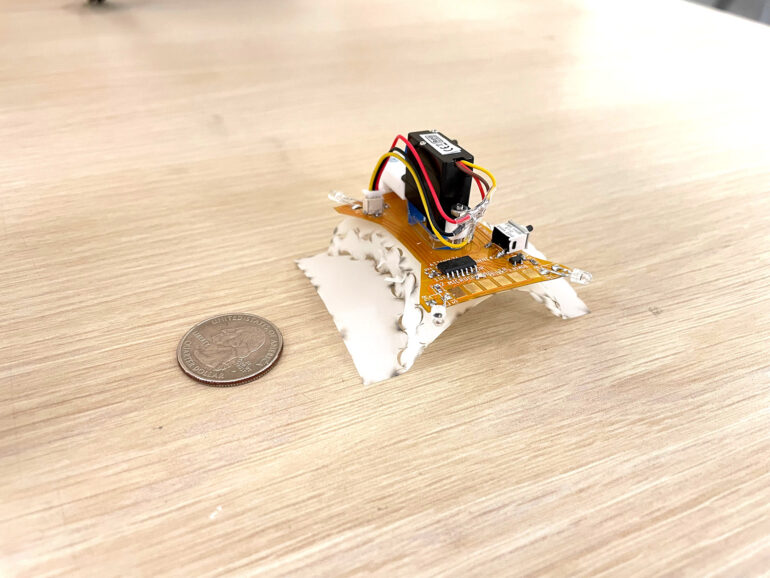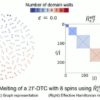Centimeter-scale walking and crawling robots are in demand both for their ability to explore tight or cluttered environments and for their low fabrication costs. Now, pulling from origami-inspired construction, researchers led by Cynthia Sung, Gabel Family Term Assistant Professor in the School of Engineering and Applied Science’s Mechanical Engineering and Applied Mechanics (MEAM) Department, have crafted a more simplified approach to the design and fabrication of these robots.
Known as CurveQuad, this centimeter-scale quadruped leverages curved-crease origami to self-fold, unfold, crawl and steer, all using a single motor. The curved creases in this technique have interesting mechanical properties as compared to more commonly used straight crease designs because they induce bending in a folded sheet. Energy, stored in the folding of creases and in the bending of panels, allows for controlled, reversible and complex motions using fewer actuators.
“The robot is able to do these things because it uses curved creases,” says Sung, also a member of Penn’s General Robotics, Automation, Sensing and Perception (GRASP) Lab. “Since it is simple and thus relatively cheap, we imagine that similar designs can be made in the future for rapid deployment of robotic swarms, which could be produced for dollars or potentially even cents per robot.”
The article, “CurveQuad: A centimeter-scale origami quadruped that leverages curved creases to self-fold and crawl with one motor,” is published in the journal Proceedings of the IEEE/RSJ International Conference on Intelligent Robots and Systems. Researchers presented their work on October 2 at the 2023 IEEE/RSJ International Conference on Intelligent Robots and Systems (IROS 2023), held in Detroit, MI.
CurveQuad’s single motor for self-folding and movement reduces the robot’s total mass and volume. The origami-inspired design also simplifies the manufacturing and assembly of a centimeter-scale robot by fabricating the entire robot, or its parts, from a few flat sheets of material, then folding it into its 3D shape, often with fully embedded electronics, actuators and computation onboard. These manufacturing processes are also scalable to large-volume production.
CurveQuad is a new addition to the sparsely populated design space of steerable, single-actuator walking robots. At just eight centimeters long and weighing approximately 11 grams, it is relatively small and light for a motor-based walking robot, says Daniel Feshbach, lead author and a doctoral student in the Sung Robotics Lab.
“The broadest implication of CurveQuad is to contribute evidence that the beautiful, smooth bending of curved folds can lead to complex and useful movement from very simple fold patterns,” he says. “The curved crease pattern is the central feature that enables CurveQuad to self-fold, crawl and steer with just one motor.”
Researchers demonstrated basic feedback control by steering the robot toward a light source from different starting positions and orientations. The team then illustrated swarm aggregation through four robots simultaneously steering toward the light. The results highlight how curved crease origami in self-assembling and deployable robots supports complex motions like locomotion. Future research will examine how small, expendable robots could explore cluttered or dangerous environments.
“The CurveQuad is part of a line of work in our lab focused on simplifying robot design and assembly so that they can be more accessible, customizable and usable to the general public,” says Sung. “Think, for example, about bringing a box of flatpack robots somewhere, having them all fold and walk around to do exploration or sensing, and then flattening back into the box for storage until the next use. We are currently working on a second version of this robot with fully integrated electronics so that we can demonstrate this capability.”
Full fabrication files and videos of the robot can be found at sung.seas.upenn.edu/publications/curvequad.
More information:
Daniel Feshbach et al, CurveQuad: A centimeter-scale origami quadruped that leverages curved creases to self-fold and crawl with one motor, Proceedings of the IEEE/RSJ International Conference on Intelligent Robots and Systems (2023). repository.upenn.edu/server/ap … 76ce9def01be/content
Provided by
University of Pennsylvania
Citation:
A centimeter-scale quadruped leverages curved-crease origami (2023, November 8)



